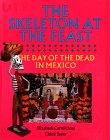Mexico book by Elizabeth Carmichael and Chloe Sayer
I came across this slender little volume in a friend’s house recently and I’m glad I took the time to read it. Less than a hundred pages, it’s a compilation of photos, drawings, essays, poems, letters, parts of novels and stories and other sources, all designed to shed light on this unique and enduring Mexican festival. I was also intrigued by the odd coincidence that I happened to read it on the actual Day of the Dead, November 2.
In Mexico – to quote Ms Sayer – the first and second of November belong to the dead. According to popular belief, the deceased have divine permission to visit friends and relatives on earth and to share the pleasures of the living. To an outsider the celebrations might seem macabre, but in Mexico death is considered a part of life. A familiar presence, it is portrayed with affection and humor by artists and crafts workers. For the Aztec, as for other ancient peoples, death signified not an end but a stage in a constant cycle. Worship of death involved worship of life, while the skull – the symbol of death – was a promise of resurrection…. The death of the individual was seen as a journey, for which numerous offerings were needed. Life is a fleeting moment – a dream – from which death awakens us.
With the Christian attitude, in contrast, death and the last judgment inspired horror and fear. Death was also a journey, but the destination was either glory or eternal damnation.
It has always seemed to me that the Spanish conquest of South America was one of the most amazing feats of history – for one country to conquer such a large area and make its language the basic means of communication for millions of people. But in this attitude to death, the conquered people were able to bring about at least one fundamental change in thinking in the minds of the conquerors and in their religious attitudes. This must be a classic case of fusion between the prevailing Catholic beliefs and the old-world attitudes to death.
I’m sure we’re all familiar with the various customs and bizarre goings-on associated with this particular day in Mexico. Like photographing dead children in their best clothes. Like the stalls that sell sugar skulls and figures in the shape of angels and souls in purgatory. Ms Sayer writes about the bakers who paint their windows with cavorting skeletons and skulls to advertise los panes de muertos (bread of the dead). And so on…
To quote Anita Brenner, one of the contributors to this volume: “City cemeteries are as full of picnickers as village graveyards. Automobiles and buses travel end on end all day, and in the cemetery itself there are lemonade stands and tintype photographers making a splendid day on arm-in-arm lovers and family groups backed by a pretentious marble slab or a churrigueresque flower arbor. Markets and parks fill out with paraphernalia of carnival except that the eating stands are delineated by an interminable row of enormous skulls….”
There are many contributors to this small volume and they all have something interesting to bring to the subject. I personally found the final essay by Octavio Paz the most useful in explaining this phenomenon. “The word death,” says Sr. Paz, “is not pronounced in New York, in Paris, in London, because it burns the lips. The Mexican, in contrast, is familiar with death, jokes about it, caresses it, sleeps with it, celebrates it, it is one of his favorite toys and his most steadfast love.”
Death, he goes on to say, is not the natural end of life but one phase of an infinite cycle. Life, death and resurrection were stages of a cosmic process which repeated itself continuously.
Long, long ago, an Aztec poet (yet another contributor) said essentially the same thing:
We come but to sleep,
we come but to dream:
It is not true, it is not true,
that we come to live upon the earth.
Like the grass each year
we are transformed;
Our hearts grow green,
put forth their shoots.
Our body is a flower: it blossoms
and then it withers.
And:
Our house on earth
we do not inhabit
Only borrow it
briefly.
In my humble O: If the subject is of any interest to you, this is one item you should have on your shelves.
 Alternate:
Alternate:
The Skeleton at the Feast
The Day of the Dead in Mexico
By Elizabeth Carmichael & Chloe Sayer
1992
Available from Amazon Books: Paperback

